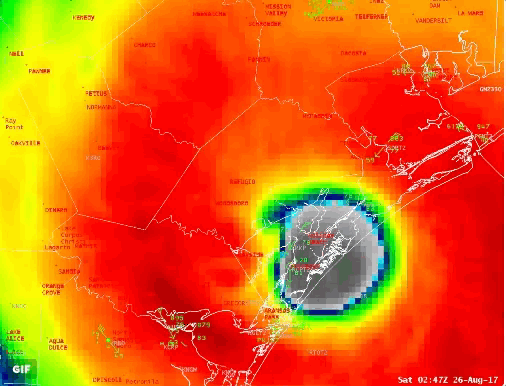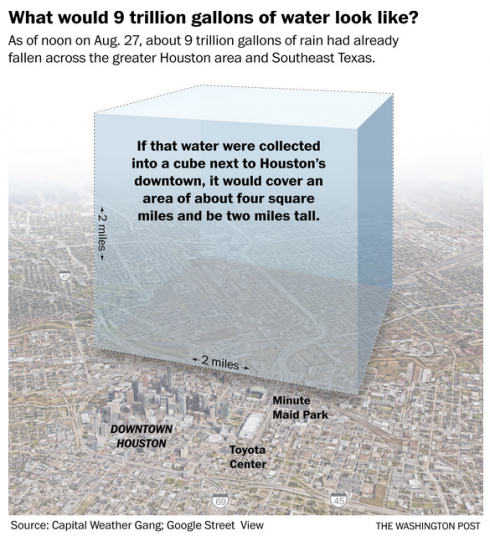Hurricane Harvey continues to dump on Texas and Louisiana
Posted By RichC on August 28, 2017
Having been away from my computer this past weekend has left me way delayed on posting the landfall of Hurricane Harvey as it piled into southeastern Texas with enough category 4 wind to pummel the coastline and an unprecedented amount of rain causing catastrophic flooding.
The residents of the fourth largest populated city of Houston are continuing to suffer as the now tropical storms movement is to the north and east. This slow progression adds to the already devastating rainfall and flooding. As if that wasn’t enough, some forecasters have Harvey scooping up more moisture from the Gulf of Mexico and threatening to flood well into Louisiana and even further east. Preliminary losses due to this storm are already making this killer hurricane (at least 8 deaths) an insurance nightmare as JPMorgan sees them as high as $20 Billion.
In the Greater Houston/Southeast Texas region, an estimated 9 trillion gallons (34 km3) of rain had fallen by the afternoon of August 27, more than any documented tropical system in U.S. history.
An additional 5 to 10 trillion gallons (19 to 38 km3) are expected before the storm dissipates. Many locations in the metro area observed at least 20 in (510 mm) of precipitation, with a maximum of 39.72 in (1,009 mm) near Dayton. The local National Weather Service office in Houston observed consecutive all-time daily rainfall accumulations on August 26 and 27, measured at 14.4 in (370 mm) and 16.08 in (408 mm) respectively. Locally, some areas may receive as much as 50 in (1,300 mm) of rain. During the storm, more than 800 Houston area flights were canceled, including 704 at George Bush Intercontinental Airport and 123 at William P. Hobby Airport. Both airports eventually closed. Several tornadoes were spawned in the area, one of which damaged or destroyed the roofs of dozens of homes in Sienna Plantation. As of August 27, six fatalities have been confirmed from flooding in the Houston area. Late on August 27, a mandatory evacuation was issued for all of Bay City as model projections indicated the downtown area would be inundated by 10 ft (3.0 m) of water. Flooding was anticipated to cut off access to the city around 1:00 p.m. CDT on August 28. On August 28, the U.S. Army Corps of Engineers began controlled water releases from Addicks and Barker Reservoirs in the Buffalo Bayou watershed in an attempt to manage flood levels in the immediate area. According to the local Corps commander, “It’s going to be better to release the water through the gates directly into Buffalo Bayou as opposed to letting it go around the end and through additional neighborhoods and ultimately into the bayou.” At the time the releases started, the reservoirs had been rising at more than 6 inches (15 cm) per hour. Throughout Texas, more than 300,000 people were left without electricity and billions of dollars of property damage was sustained. The refinery industry capacity was reduced, and oil and gas production was affected in the Gulf of Mexico and inland Texas.



Comments